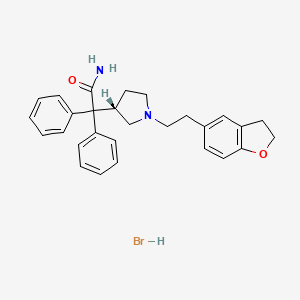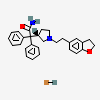Darifenacin Hydrobromide
- Darifenacin hydrobromide
- darifenacin HBr
- 133099-07-7
- Enablex
- Emselex
- Create:2005-06-24
- Modify:2025-01-11
 Darifenacin (has active moiety).
Darifenacin (has active moiety).
- (S)-1-(2-(2,3-dihydro-5-benzofuranyl)ethyl)-alpha,alpha-diphenyl-3-pyrrolidineacetamide
- darifenacin
- darifenacin hydrobromide
- darifenacin hydrochloride
- darifenacine
- darifenicin
- Emselex
- Enablex
- UK-88525
- Darifenacin hydrobromide
- darifenacin HBr
- 133099-07-7
- Enablex
- Emselex
- Darilong
- Darifenacin (hydrobromide)
- UK 88525-04 hydrobromide
- UNII-CR02EYQ8GV
- CR02EYQ8GV
- 2-[(3S)-1-[2-(2,3-dihydro-1-benzofuran-5-yl)ethyl]pyrrolidin-3-yl]-2,2-diphenylacetamide hydrobromide
- UK-88525-04 (HYDROBROMIDE)
- Darifenacin hydrobromide [USAN]
- DTXSID9046780
- CHEBI:31455
- Uk-88525-04 (hbr)
- 3-PYRROLIDINEACETAMIDE, 1-[2-(2,3-DIHYDRO-5-BENZOFURANYL)ETHYL]-ALPHA,ALPHA-DIPHENYL-, HYDROBROMIDE (1:1), (3S)-
- DTXCID7026780
- (S)-2-(1-(2-(2,3-dihydrobenzofuran-5-yl)ethyl)pyrrolidin-3-yl)-2,2-diphenylacetamide hydrobromide
- 133099-07-7 (HBr)
- (S)-2-{1-(2-(2,3-Dihydrobenzofuran-5-yl)ethyl)-3-pyrrolidnyl}-2,2-diphenylacetamide hydrobromide
- 3-Pyrrolidineacetamide, 1-(2-(2,3-dihydro-5-benzofuranyl)ethyl)-alpha,alpha-diphenyl-, monohydrobromide, (3S)-
- 3-Pyrrolidineacetamide, 1-(2-(2,3-dihydro-5-benzofuranyl)ethyl)-alpha,alpha-diphenyl-, monohydrobromide, (S)-
- DARIFENACIN HYDROBROMIDE (MART.)
- DARIFENACIN HYDROBROMIDE [MART.]
- DARIFENACIN HYDROBROMIDE (USP-RS)
- DARIFENACIN HYDROBROMIDE [USP-RS]
- (S)-2-(1-(2-(2,3-DIHYDROBENZOFURAN-5-YL)ETHYL)-3-PYRROLIDNYL)-2,2-DIPHENYLACETAMIDE HBR
- 2-[(3S)-1-[2-(2,3-dihydro-1-benzofuran-5-yl)ethyl]pyrrolidin-3-yl]-2,2-diphenylacetamide;hydrobromide
- CAS-133099-07-7
- NCGC00168775-01
- (S)-2-(1-(2-(2,3-DIHYDROBENZOFURAN-5-YL)ETHYL)-3-PYRROLIDNYL)-2,2-DIPHENYLACETAMIDE HYDROBROMIDE
- (S)-2-{1-[2-(2,3-Dihydrobenzofuran-5-yl)ethyl]-3-pyrrolidnyl}-2,2-diphenylacetamide hydrobromide
- 2-((3S)-1-(2-(2,3-dihydro-1-benzofuran-5-yl)ethyl)pyrrolidin-3-yl)-2,2-diphenylacetamide hydrobromide
- 2-{(3S)-1-[2-(2,3-dihydro-1-benzofuran-5-yl)ethyl]pyrrolidin-3-yl}-2,2-diphenylacetamide hydrobromide
- Darifenacin 15 mg
- Enablex (TN)
- MFCD08141803
- Darifenacin 7.5 mg
- Darifenacinhydrobromide
- Diphenyl-acetamide hydrobromide
- Darifenacin hydrobromide- Bio-X
- CHEMBL1200935
- HY-A0012R
- HY-A0012
- Tox21_112636
- Darifenacin hydrobromide (JAN/USAN)
- DARIFENACIN HYDROBROMIDE [MI]
- s3144
- DARIFENACIN HYDROBROMIDE [JAN]
- AKOS015969311
- Darifenacin (hydrobromide) (Standard)
- Tox21_112636_1
- AC-1894
- CCG-220969
- CS-0380
- DARIFENACIN HYDROBROMIDE [WHO-DD]
- NCGC00263922-02
- AS-35087
- BD164350
- DARIFENACIN HYDROBROMIDE [EMA EPAR]
- Darifenacin hydrobromide, >=98% (HPLC)
- SW219426-1
- DARIFENACIN HYDROBROMIDE [ORANGE BOOK]
- UK-88525-04
- D01699
- EN300-123031
- Q-101006
- Q27114313
- Z1546616192
- Darifenacin hydrobromide, United States Pharmacopeia (USP) Reference Standard
- (S)-2-(1-(2-(2,3-Dihydrobenzofuran-5-yl)ethyl)pyrrolidin-3-yl)-2,2-diphenyl acetamide monohydribrimide
- 3-PYRROLIDINEACETAMIDE, 1-(2-(2,3-DIHYDRO-5-BENZOFURANYL)ETHYL)-.ALPHA.,.ALPHA.-DIPHENYL-, MONOHBR, (3S)-
- 3-PYRROLIDINEACETAMIDE, 1-(2-(2,3-DIHYDRO-5-BENZOFURANYL)ETHYL)-.ALPHA.,.ALPHA.-DIPHENYL-, MONOHYDROBROMIDE, (3S)-
- 3-PYRROLIDINEACETAMIDE, 1-(2-(2,3-DIHYDRO-5-BENZOFURANYL)ETHYL)-alpha,alpha-DIPHENYL-, MONOHBR, (3S)-
427.240570 100
428.242981 48.47
147.081055 45.15
429.245026 7.55
148.083633 4.14
 Darifenacin (has active moiety)
Darifenacin (has active moiety)
H315 (95.1%): Causes skin irritation [Warning Skin corrosion/irritation]
H319 (100%): Causes serious eye irritation [Warning Serious eye damage/eye irritation]
H335 (95.1%): May cause respiratory irritation [Warning Specific target organ toxicity, single exposure; Respiratory tract irritation]
P261, P264, P264+P265, P271, P280, P302+P352, P304+P340, P305+P351+P338, P319, P321, P332+P317, P337+P317, P362+P364, P403+P233, P405, and P501
(The corresponding statement to each P-code can be found at the GHS Classification page.)
Aggregated GHS information provided per 41 reports by companies from 3 notifications to the ECHA C&L Inventory. Each notification may be associated with multiple companies.
Information may vary between notifications depending on impurities, additives, and other factors. The percentage value in parenthesis indicates the notified classification ratio from companies that provide hazard codes. Only hazard codes with percentage values above 10% are shown.
Skin Irrit. 2 (95.1%)
Eye Irrit. 2 (100%)
STOT SE 3 (95.1%)
Patents are available for this chemical structure:
https://patentscope.wipo.int/search/en/result.jsf?inchikey=UQAVIASOPREUIT-VQIWEWKSSA-N
- CAS Common ChemistryLICENSEThe data from CAS Common Chemistry is provided under a CC-BY-NC 4.0 license, unless otherwise stated.https://creativecommons.org/licenses/by-nc/4.0/Darifenacin hydrobromidehttps://commonchemistry.cas.org/detail?cas_rn=133099-07-7
- ChemIDplusDarifenacin hydrobromide [USAN]https://pubchem.ncbi.nlm.nih.gov/substance/?source=chemidplus&sourceid=0133099077ChemIDplus Chemical Information Classificationhttps://pubchem.ncbi.nlm.nih.gov/source/ChemIDplus
- EPA DSSToxDarifenacin hydrobromidehttps://comptox.epa.gov/dashboard/DTXSID9046780CompTox Chemicals Dashboard Chemical Listshttps://comptox.epa.gov/dashboard/chemical-lists/
- European Chemicals Agency (ECHA)LICENSEUse of the information, documents and data from the ECHA website is subject to the terms and conditions of this Legal Notice, and subject to other binding limitations provided for under applicable law, the information, documents and data made available on the ECHA website may be reproduced, distributed and/or used, totally or in part, for non-commercial purposes provided that ECHA is acknowledged as the source: "Source: European Chemicals Agency, http://echa.europa.eu/". Such acknowledgement must be included in each copy of the material. ECHA permits and encourages organisations and individuals to create links to the ECHA website under the following cumulative conditions: Links can only be made to webpages that provide a link to the Legal Notice page.https://echa.europa.eu/web/guest/legal-notice(S)-2-[1-[2-(2,3-dihydrobenzofuran-5-yl)ethyl] pyrrolidin-3-yl] -2,2-diphenyl-acetamid hydrobromidehttps://echa.europa.eu/substance-information/-/substanceinfo/100.116.745(S)-2-[1-[2-(2,3-dihydrobenzofuran-5-yl)ethyl] pyrrolidin-3-yl] -2,2-diphenyl-acetamid hydrobromide (EC: 603-705-7)https://echa.europa.eu/information-on-chemicals/cl-inventory-database/-/discli/details/51871
- FDA Global Substance Registration System (GSRS)LICENSEUnless otherwise noted, the contents of the FDA website (www.fda.gov), both text and graphics, are not copyrighted. They are in the public domain and may be republished, reprinted and otherwise used freely by anyone without the need to obtain permission from FDA. Credit to the U.S. Food and Drug Administration as the source is appreciated but not required.https://www.fda.gov/about-fda/about-website/website-policies#linkingDARIFENACIN HYDROBROMIDEhttps://gsrs.ncats.nih.gov/ginas/app/beta/substances/CR02EYQ8GV
- ChEBIDarifenacin hydrobromidehttps://www.ebi.ac.uk/chebi/searchId.do?chebiId=CHEBI:31455
- Open TargetsLICENSEDatasets generated by the Open Targets Platform are freely available for download.https://platform-docs.opentargets.org/licenceDARIFENACIN HYDROBROMIDEhttps://platform.opentargets.org/drug/CHEMBL1200935
- ChEMBLLICENSEAccess to the web interface of ChEMBL is made under the EBI's Terms of Use (http://www.ebi.ac.uk/Information/termsofuse.html). The ChEMBL data is made available on a Creative Commons Attribution-Share Alike 3.0 Unported License (http://creativecommons.org/licenses/by-sa/3.0/).http://www.ebi.ac.uk/Information/termsofuse.htmlChEMBL Protein Target Treehttps://www.ebi.ac.uk/chembl/g/#browse/targets
- DailyMedDARIFENACIN HYDROBROMIDEhttps://dailymed.nlm.nih.gov/dailymed/search.cfm?labeltype=all&query=DARIFENACIN+HYDROBROMIDE
- Drugs@FDALICENSEUnless otherwise noted, the contents of the FDA website (www.fda.gov), both text and graphics, are not copyrighted. They are in the public domain and may be republished, reprinted and otherwise used freely by anyone without the need to obtain permission from FDA. Credit to the U.S. Food and Drug Administration as the source is appreciated but not required.https://www.fda.gov/about-fda/about-website/website-policies#linkingDARIFENACIN HYDROBROMIDEhttps://www.accessdata.fda.gov/scripts/cder/daf/
- European Medicines Agency (EMA)LICENSEInformation on the European Medicines Agency's (EMA) website is subject to a disclaimer and copyright and limited reproduction notices.https://www.ema.europa.eu/en/about-us/legal-noticeEmselex (EMEA/H/C/000554)https://www.ema.europa.eu/en/medicines/human/EPAR/emselex
- FDA Orange BookLICENSEUnless otherwise noted, the contents of the FDA website (www.fda.gov), both text and graphics, are not copyrighted. They are in the public domain and may be republished, reprinted and otherwise used freely by anyone without the need to obtain permission from FDA. Credit to the U.S. Food and Drug Administration as the source is appreciated but not required.https://www.fda.gov/about-fda/about-website/website-policies#linking
- KEGGLICENSEAcademic users may freely use the KEGG website. Non-academic use of KEGG generally requires a commercial licensehttps://www.kegg.jp/kegg/legal.htmlUSP drug classificationhttp://www.genome.jp/kegg-bin/get_htext?br08302.kegAnatomical Therapeutic Chemical (ATC) classificationhttp://www.genome.jp/kegg-bin/get_htext?br08303.kegTarget-based classification of drugshttp://www.genome.jp/kegg-bin/get_htext?br08310.keg
- MassBank of North America (MoNA)LICENSEThe content of the MoNA database is licensed under CC BY 4.0.https://mona.fiehnlab.ucdavis.edu/documentation/license
- National Drug Code (NDC) DirectoryLICENSEUnless otherwise noted, the contents of the FDA website (www.fda.gov), both text and graphics, are not copyrighted. They are in the public domain and may be republished, reprinted and otherwise used freely by anyone without the need to obtain permission from FDA. Credit to the U.S. Food and Drug Administration as the source is appreciated but not required.https://www.fda.gov/about-fda/about-website/website-policies#linkingDARIFENACIN HYDROBROMIDEhttps://www.fda.gov/drugs/drug-approvals-and-databases/national-drug-code-directory
- NCI Thesaurus (NCIt)LICENSEUnless otherwise indicated, all text within NCI products is free of copyright and may be reused without our permission. Credit the National Cancer Institute as the source.https://www.cancer.gov/policies/copyright-reuseNCI Thesaurushttps://ncit.nci.nih.gov
- NLM RxNorm TerminologyLICENSEThe RxNorm Terminology is created by the National Library of Medicine (NLM) and is in the public domain and may be republished, reprinted and otherwise used freely by anyone without the need to obtain permission from NLM. Credit to the U.S. National Library of Medicine as the source is appreciated but not required. The full RxNorm dataset requires a free license.https://www.nlm.nih.gov/research/umls/rxnorm/docs/termsofservice.htmldarifenacin hydrobromidehttps://rxnav.nlm.nih.gov/id/rxnorm/485417
- Springer Nature
- Wikidatadarifenacin hydrobromidehttps://www.wikidata.org/wiki/Q27114313
- PubChem
- Medical Subject Headings (MeSH)LICENSEWorks produced by the U.S. government are not subject to copyright protection in the United States. Any such works found on National Library of Medicine (NLM) Web sites may be freely used or reproduced without permission in the U.S.https://www.nlm.nih.gov/copyright.htmldarifenacinhttps://www.ncbi.nlm.nih.gov/mesh/67101207Muscarinic Antagonistshttps://www.ncbi.nlm.nih.gov/mesh/68018727Urological Agentshttps://www.ncbi.nlm.nih.gov/mesh/68064804
- GHS Classification (UNECE)GHS Classification Treehttp://www.unece.org/trans/danger/publi/ghs/ghs_welcome_e.html
- MolGenieMolGenie Organic Chemistry Ontologyhttps://github.com/MolGenie/ontology/
- PATENTSCOPE (WIPO)SID 389327105https://pubchem.ncbi.nlm.nih.gov/substance/389327105
- NCBI


 CID 260 (Hydrobromic Acid)
CID 260 (Hydrobromic Acid)